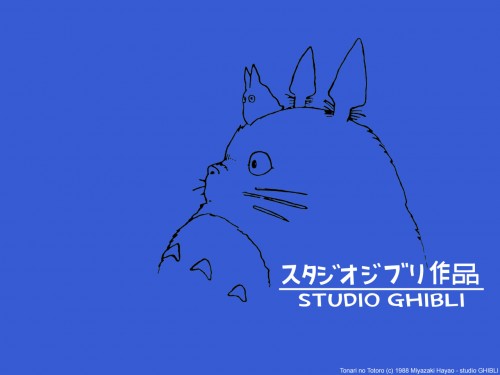The Films Of Studio Ghibli: A Retrospective

"Nausicaä of the Valley of the Wind" (1984)- Technically released before the studio was established, "Nausicaä" is still widely considered a part of the Ghibli canon due to the talent involved. It has that distinct Miyazaki feel, and includes the themes of pacifism, flight, environmentalism, and young female protagonists found in many of the director's later efforts.
"Castle in the Sky" (1986)- The first official Ghibli release was a wonderful fantasy about a boy finding a girl who falls peacefully to Earth before teaming up with sky pirates to discover the secrets of Laputa, a sort of floating Atlantis hidden in the clouds. Gorgeous, action-packed, and one of the rare Miyazaki films with a truly evil villain. It's a ton of fun.
"Grave of the Fireflies" (1988)- A powerful wartime tragedy from Isao Takahata about a brother (fourteen years old), and sister (only four) in the aftermath of the firebombing of their home in Kobe during WWII. Undoubtedly one of the most powerful films you could ever see, it will crush you. But it's absolutely necessary.
"My Neighbor Totoro" (1988)- And on the exact opposite end of the spectrum we have My Neighbor Totoro, the source of the adorable forest spirit that Studio Ghibli adopted as its logo. This little effort from Miyazaki, about two girls living with their dad and encountering a few inexplicable, adorable creatures, is absolutely guaranteed to instill anyone who sees it with an electric glee. This movie will make you smile. Guaranteed.
"Kiki's Delivery Service" (1989)- Probably the weakest of Miyazaki's efforts, it says a lot that this movie is, at worst, pretty okay. It tells the simple story of a young witch moving out to the big city and finding out who she wants to be. It's pretty slight, but there really isn't anything wrong with it besides that. This is actually one that a fair few children of the nineties might have had a chance to see growing up.
"Only Yesterday" (1991)- A thoughtful look at a woman's identity, this film from Takahata is unique in that it appealed primarily to older, female audiences. A great example that the medium can do plenty of things people don't traditionally associate with animation.

"Pom Poko" (1994)- Takahata's take on Japanese folklore, this tale of the tanuki may not hold that much appeal for American audiences. If you're interested it might pay to do some research first, or risk missing a ton of cultural references.
"Whisper of the Heart" (1995)- The first Ghibli director other than Miyazaki or Takahata, Yoshifumi Kondo was intended as the successor to the anime throne before his tragic and sudden death a few years after he debuted with this film, a touching and inspiring look at the power of creativity and animation.
"Princess Mononoke" (1997)- The most outwardly mature of Miyazaki's movies, anyone going in only exposed to the director's more benign works could easily find themselves shocked by some brutal, violent flourishes early on. This might be the most epic film Miyazaki has ever done, a high stakes struggle between man and nature that makes environmentalism seem really cool while ensuring every character is a fully thought out, three-dimensional participant in the events, with believable motives anyone could understand. Would be worth it just for the insanely impressive visual design of the creature in the opening action scene. Notably, this is the movie responsible for first really bringing the efforts of Studio Ghibli to the attention of (the most observant) American audiences, with a celebrity-rich dub and a localized script from the pen of one Mr. Neil Gaiman. How cool is that?
"My Neighbors the Yamadas" (1999)- A very unique family comedy from Takahata that depicts a series of vignettes in a comic strip style that sets it apart visually from anything else on this list.

"The Cat Returns" (2002)- A fantasy film that takes place in the world imagined by the protagonist of Whisper of the Heart, creating a cool little "shared worlds" vibe between the studio's productions.
"Howl's Moving Castle" (2004)- It's rarely the best thing for the production when the director leaves the project, but a very notable exception would be when Mamoru Hosoda's exodus brought Miyazaki out of retirement to adapt this delightful story of a girl transformed into an old woman by a witch's curse. She falls in with Howl, an enigmatic magician who embodies the director's passionate anti-war stance, an already prominent side of him that was further inflamed by the start of US involvement in Iraq. Christian Bale, an admirer of Miyazaki's work, actively pursued the role of Howl for the US dub. Sure enough, he's a perfect fit, but the real highlight is Billy Crystal as Calcifer, a living fire that would fit comfortably in the pantheon of Disney sidekicks, and in fact outclasses most of them.
"Tales from Earthsea" (2006)- Probably the most divisive Ghibli film (in that it isn't universally praised), this fantasy loosely adapted from the Earthsea series was the directorial debut of Goro Miyazaki, following in his father's incredibly daunting footsteps.

"The Secret World of Arrietty" (2010)- Newly released in North America, this Miyazaki-scripted adaptation of The Borrowers series of children's books comes from Hiromasa Yonebayashi, youngest director in Ghibli's history. A wonderful little adventure, be sure to check out our review.
As their worldwide popularity continues growing with each film, Ghibli further solidifies its position as an animation powerhouse. With such a consistent track record, this is nothing but great news. Here's to the studio's continued success, and all the amazing worlds they have yet to show us.



